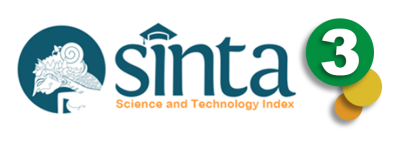ANALISIS FAKTOR-FAKTOR YANG MEMPENGARUHI PENDAPATAN PADI ORGANIK DI KECAMATAN HARAU
Abstract
Excessive use of chemical fertilizers causes a decrease in soil quality so that rice production decreases, even though the production costs incurred by farmers continue to increase due to the increasing price of chemical fertilizers. The purpose of this study was to determine what factors affect the income of organic rice farmers. This study used a survey method, where the determination of the research area was carried out deliberately and selected Nagari Koto Tuo Harau District. Determination of research samples using proportional stratified random sampling method, where the number of samples is 25 farmers. Data collection is done by interview and direct observation. Data analysis method used is kunatitatif analysis using multiple linear regression analysis. The results showed that the factors that significantly affect the income of organic rice farmers are land area, production costs, the amount of rice production and the price of rice. While the factors that affect insignificantly are age, education and other jobs.
Keywords: Analysis, rice, organic, Yield
Downloads
References
Channabasavanna, A. S., Biradar, D. P., Prabhudev, K. N., & Hegde, M. (2009). Development of profitable integrated farming system model for small and medium farmers of Tungabhadra project area of Karnataka. Karnataka J. Agric. Sci, 22(1), 25–27.
Devendra, C. (2011). Integrated tree crops-ruminants systems in South East Asia: Advances in productivity enhancement and environmental sustainability. Asian-Australasian Journal of Animal Sciences, 24(5), 587–602. https://doi.org/10.5713/ajas.2011.r.07
Hilimire, K. (2011). Integrated crop/livestock agriculture in the United States: A review. Journal of Sustainable Agriculture, 35(4), 376–393. https://doi.org/10.1080/10440046.2011.562042
Jaishankar, N., Janagoudar, B. S., Kalmath, B., Naik, V. P., & Siddayya, S. (2014). Integrated Farming for Sustainable Agriculture and Livelihood Security to Rural Poor. 22–24. https://doi.org/10.17758/iaast.a0514013
Jayanthi, C., Vennila, C., Nalini, K., & Chandrasekaran, B. (2009). Sustainable integrated management of crop with allied enterprises. Sustainable Agriculture, 21–27.
Massinai, R. (2012). Pengembangan Model Agroindustri Berbasis Sistem Usahatani Terpadu.
Mukhlis. (2020). Analisa Pendapatan Petani Integrasi Padi-Sapi pada Kelompok Tani Pemuda Setia Nagari Simalanggang. LUMBUNG Politeknik Pertanian Negeri Payakumbuh, 19(1), 40–47.
Mukhlis, Hendriani, R., Sari, R. I. K., & Sari, N. (2022). Analisis Produksi dan Faktor Produksi Usaha Tani Terpadu Tanaman Padi dan Ternak Sapi di Nagari Taram Kecamatan Harau. Jurnal Penelitian Pertanian Terapan, 22(2), 104–110. https://doi.org/10.25181/jppt.v22i2.2581
Nurcholis, M., & Supangkat, G. (2011). Pengembangan Integrated Farming System Untuk Pengendalian Alih Fungsi Lahan Pertanian. Budidaya Pertanian Urgensi Dan Strategi Pengendalian Alih Fungsi Lahan Pertanian, 71–84.
Rianse, U., & Abdi. (2012). Metodologi Penelitian Sosial dan Ekonomi-Teori dan Aplikasi. Alfabeta.
Salikin, K. (2003). Sistem Pertanian Berkelanjutan (1st ed.). Kanisius.
Soepono, B. (1997). Statistik Terapan. Rineka Cipta.
Sofian, E., & Singarimbun, M. (2012). Metode Penelitian Survei. LP3ES.
Sudadi, M., & dan Widada. (2002). Agribisnis Kemitraan Usaha Bersama: Upaya Peningkatan Kesejahteraan Petani. Kanisius.
Sugiono. (2013). Metode Penelitian Kuantitatif dan Kualitatif dan R&G (p. h. 8). Alfabeta.
Sutanto, R. (2002). Penerapan pertanian organik : Pemasyarakatan dan pengembangannya. Kanisius.
Thorat, B. N., Thombre, B. M., & Dadge, A. V. (2015). B. N. Thorat*, B. M. Thombre and A. V. Dadge. 33(2), 653–657.
Ugwumba, C. O. A., Okoh, R. N., Ike, P. C., Nnabuife, E. L. C., & Orji, E. C. (2010). Integrated Farming System and its Effect on Farm Cash Income in Awka South Agricultural Zone of Anambra State, Nigeria. J. Agric. & Environ. Sci, 8(1), 1–06.
Walia, S. S., & Kaur, N. (2013). Integrated Farming System - An Ecofriendly Approach for Sustainable Agricultural Environment – A Review. Greener Journal of Agronomy, Forestry and Horticulture, 1(1), 001–011. https://doi.org/10.15580/gjafh.2013.1.071813740

This work is licensed under a Creative Commons Attribution 4.0 International License.





















